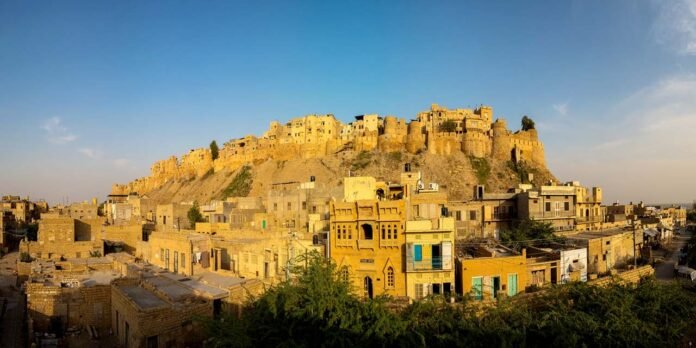The History Behind Jaisalmer Fort
Jaisalmer Fort was built in 1156 AD by Rawal Jaisal, a Rajput ruler from the Bhati clan. Perched on Trikuta Hill, the fort was strategically designed to provide a vantage point over the desert trade routes. Over the centuries, it has witnessed numerous battles, sieges, and dynastic shifts, all of which have left indelible marks on its architecture and heritage.
One of the most intriguing aspects of Jaisalmer Fort is how it has adapted to modern times while maintaining its ancient charm. With over 4,000 people residing inside, the fort functions as a small town with houses, temples, shops, and cafes—all thriving in the labyrinthine lanes that wind through the fort. This rare blend of history and modernity is what makes Jaisalmer Fort a living monument, not just an ancient relic.
Architectural Grandeur: A Blend of Rajput and Islamic Styles
When you step inside the fort, the sheer grandeur of its architecture leaves an unforgettable impression. The Rajput architectural style, which blends with Islamic influences, dominates the design. The use of yellow sandstone for construction is what gives Jaisalmer Fort its golden glow.
Intricate Carvings and Detailed Stonework
One of the most notable features of the fort is its intricate stone carvings, which adorn the walls, windows, and balconies. These carvings are remarkably detailed, showcasing the craftsmanship of skilled artisans from centuries ago. Many of these carvings depict mythological scenes, local legends, and motifs inspired by nature. The Jain Temples inside the fort are especially known for their fine stonework, offering a spiritual as well as an aesthetic experience to visitors.
The Raj Mahal (Royal Palace)
At the heart of Jaisalmer Fort stands the Raj Mahal, the royal palace that once housed the rulers of Jaisalmer. The palace is a fine example of medieval Rajput architecture and features multiple floors, interconnected courtyards, and elaborate balconies overlooking the city below. Today, sections of the palace have been converted into museums, where visitors can explore artifacts from the royal era, including weapons, manuscripts, and historical artworks.
A Living Fort: The People of Jaisalmer Fort
What truly sets Jaisalmer Fort apart from other historical monuments is that it is still inhabited. The fort has over 4,000 residents, many of whom are descendants of the original inhabitants who settled here centuries ago. These residents live in traditional sandstone houses, which are themselves a part of the fort’s architectural heritage.
As you walk through the narrow, winding lanes, you’ll find local artisans working on handicrafts, shops selling traditional Rajasthani textiles, and cafes offering delicious local cuisine. This living, breathing fort is more than just a historical monument—it’s a cultural experience where visitors can interact with the people who continue to keep its traditions alive.
Experiencing Jaisalmer Fort Today
Exploring Jaisalmer Fort is like stepping into a time capsule, yet with all the conveniences of modern tourism. Visitors can take guided tours that offer in-depth insights into the fort’s history and architecture, or they can simply wander through its lanes, soaking in the atmosphere at their own pace.
Visiting the Jain Temples
One of the highlights of a visit to Jaisalmer Fort is the chance to explore its seven Jain Temples, built between the 12th and 16th centuries. These temples are not only places of worship but also architectural marvels. Carved from yellow sandstone, they feature intricately designed domes, arches, and pillars that tell the story of Jain religious art. The temples house beautiful sculptures and statues of Jain Tirthankaras, and visitors often describe the ambiance here as peaceful and serene.
Sunset Views and Photography
Due to its location on Trikuta Hill, Jaisalmer Fort offers breathtaking views of the surrounding desert. At sunset, the entire fort seems to glow in shades of gold, making it a photographer’s paradise. Many visitors head to the fort’s outer ramparts in the evening to capture panoramic views of the Thar Desert and the old city below.
Where to Stay: Experiencing the Desert in Luxury
While Jaisalmer Fort is a must-visit attraction, no trip to this desert city is complete without experiencing the unique luxury offered by local desert camps. A stay at a Jaisalmer Desert Camp is an opportunity to immerse yourself in the raw beauty of the Thar Desert. These camps offer luxury accommodations and cultural experiences like camel safaris, traditional Rajasthani folk music, and star-gazing under the clear desert sky.
For those looking for a truly exceptional stay, Luxury Camps in Jaisalmer provide an exclusive experience. Guests enjoy modern amenities while being surrounded by the vast, unspoiled desert landscape. These camps are perfect for travelers who want to blend adventure with comfort, offering a unique way to experience the Thar Desert’s serenity and the vibrant culture of Rajasthan.
Conclusion: Why Jaisalmer Fort Should Be on Your Travel Bucket List
Jaisalmer Fort is not just a monument; it is a living citadel where history and modern life co-exist harmoniously. From its stunning architecture to the vibrant community that calls it home, the fort offers an immersive experience into Rajasthan’s royal past and present-day culture. Whether you’re a history enthusiast, a culture lover, or simply a traveler seeking beauty, Jaisalmer Fort has something to offer everyone.
In addition, combining your visit to the fort with a stay at a luxury desert camp enriches your experience of Jaisalmer, allowing you to witness both the grandeur of the fort and the untouched beauty of the Thar Desert. A trip to Jaisalmer is more than just a vacation—it’s a journey into the heart of Rajasthan’s timeless legacy.



